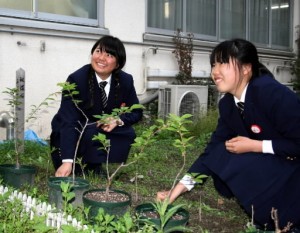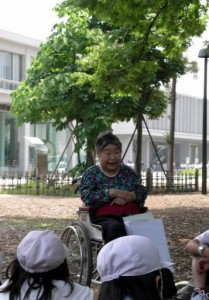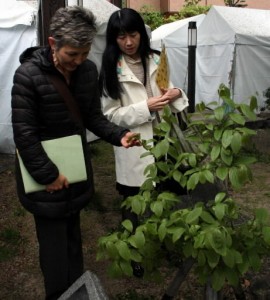Peace Seeds: Hiroshima Teens Report on Peace Issues, Part 2
May 19, 2014
A-bomb survivor trees: “Silent witnesses”
In Japan and abroad
About 170 camphor, ginkgo and other trees within a 2 km radius of the hypocenter have been designated by the City of Hiroshima as survivors of the atomic bombing. Damaged by their exposure to the thermal rays and the blast, these “silent witnesses” of the A-bombing nevertheless survived. Today they convey the value of life to people around the world, transcending cultural and language differences. Various organizations, private citizens and government agencies have dedicated themselves to the preservation of the trees, and there is a growing effort to send seeds and seedlings to various locations in Japan and around the world.
Yasuda Girls’ High School sending cherry tree seedlings
Trees’ ability to survive inspire hope
Story and photo by Ishin Nakahara
Yasuda Girls’ High School lost 311 students and 13 teachers in the atomic bombing of Hiroshima. Four months later the school was rebuilt at its present location in Naka Ward on the former premises of an engineering brigade, about 2.1 km from the hypocenter. At that time, there was one cherry tree on the site.
After the atomic bombing, the tree continued to put forth beautiful blossoms as if it wanted later generations to see that it had endured hardships. With a desire to let others know of the tree’s ability to survive, six years ago the school’s student council began growing seedlings from the tree. So far the school has sent 72 seedlings to 62 schools and organizations throughout Japan.
The seedlings were produced by grafting small branches from the cherry tree onto the trunks of other trees. The students get instruction from experts, but only about 30 percent of the grafts have been successful. Grafting the branches onto the trees is indeed a process of trial and error.
The group has also sent seedlings to Fukushima Prefecture, where the accident at the nuclear power plant occurred at the time of the Tohoku Earthquake and Tsunami in 2011. This led to exchanges between the two schools, and students from the school that received the seedlings came to Hiroshima to see the cherry tree on a school trip. Ayane Nariai, 18, a senior at Yasuda Girls’ High School and president of the student council, said, “At first we were concerned about how people would feel about having seedlings from an A-bomb survivor tree given to them. So we were really happy when people in Fukushima said Hiroshima gave them hope.”
There are many other trees in Hiroshima that survived the atomic bombing. Despite their terrible experiences, even now we can see them putting out new leaves. I would like many people to be aware of these trees and to be inspired by them.
Chinese parasol tree that survived A-bombing
Effort to spread seeds
A-bomb survivor’s wish carried out
by Haruka Shinmoto and Marika Tsuboki
An organization that works to plant seeds from a Chinese parasol tree that survived the atomic bombing was established by the late Suzuko Numata, an A-bomb survivor who for many years recounted her experiences near the tree in Peace Memorial Park. The group sends seeds throughout Japan and has planted seedlings from the tree at Nijo Castle and Kinkakuji Temple in Kyoto.
Ms. Numata was at work about 1.4 km from the hypocenter at the time of the atomic bombing. Trapped beneath the collapsed building, she lost her left leg. She said that when she despaired of life, she was encouraged by the sight of new growth on the Chinese parasol tree that had survived the A-bombing. When telling of her experiences, she gave her listeners seeds from the tree. These seeds have led to the growth of second-generation trees in many areas in Japan and abroad.
Five years ago an effort began to take seeds from those trees and propagate third-generation trees. But Ms. Numata died in July 2011 at the age of 87. Yutaka Miki, 60, current leader of the group, said, “I want to make sure that Ms. Numata’s wish is carried out in many locations.”
Ms. Numata was reportedly distressed by the bullying and suicide of children. She maintained a dialogue with people from other Asian countries who were hostile toward Japan on account of its actions during the war. She understood the importance of sympathizing with others as a human being and said she wanted people to “be kind to others and respect life.” I would like to carry on the hopes Ms. Numata placed in the Chinese parasol tree.
Green Legacy Hiroshima
Caring for trees can lead to desire for nuclear abolition
by Miku Yamashita
Green Legacy Hiroshima began three years ago as a project of the Hiroshima Office of the United Nations Institute for Training and Research (UNITAR) and ANT-Hiroshima, a non-profit organization.
Nassrine Azimi, 55, a native of Iran, serves as one of the co-coordinators. After working in various other countries, she came to Hiroshima in 2003 and served as the director of UNITAR’s local office for about six years. She believes that the desire to care for the trees will lead to a desire to abolish nuclear weapons, which take lives, and it was this belief that inspired her to launch the project.
Seeds have been collected and stored with the assistance of the Hiroshima Botanical Garden and Chikara Horiguchi, a well-known tree doctor. Seeds and seedlings from camphor and other trees have been sent to about 20 countries, including Russia and Singapore.
Many countries have strict regulations on the importation of non-native plants, and the procedures for sending seeds and seedlings overseas are cumbersome. In some instances seeds have not sprouted or seedlings have died after reaching their destination. Nevertheless Ms. Azimi said it is a great pleasure to have people take an interest in the survivor trees.
Though there may seem to be little relationship between trees and nuclear abolition, Ms. Azimi believes that “everything is connected.” We too will take another look to see what we can do close to home.
Junior Writers’ Comments
It was my first interview, and I was really nervous. At first I wasn’t able to ask some of the questions I wanted to ask, but as Mr. Miki talked to us enthusiastically I just naturally started asking questions. Next time I want to be more outgoing when interviewing and write a better article. (Haruka Shinmoto, 1st-year high school student)
It was my first time to interview someone who had come from overseas. I was worried about whether I’d be able to converse in English, but both Ms. Azimi and Ms. Yamada, the interpreter, spoke to me warmly so I could ask questions without being nervous. It was an enjoyable interview. (Nui Morimoto, 1st-year high school student)
This was my first assignment since becoming a junior writer. I had wanted to interview a foreigner sometime, but it came about very soon and I was really happy about it. Ms. Azimi was always smiling and very friendly. I felt I’d like to be a strong woman like her who works toward a goal. (Miku Yamashita, 1st-year high school student)
In order to write about Yasuda Girls’ High School’s activities in more detail, I had to gather a lot of information and then put the article together. It was much more difficult than any assignment I’ve had before, but covering the story with other high school students my age was a new experience and a lot of fun. (Ishin Nakahara, 1st-year high school student)
(Originally published on May 19, 2014)
In Japan and abroad
About 170 camphor, ginkgo and other trees within a 2 km radius of the hypocenter have been designated by the City of Hiroshima as survivors of the atomic bombing. Damaged by their exposure to the thermal rays and the blast, these “silent witnesses” of the A-bombing nevertheless survived. Today they convey the value of life to people around the world, transcending cultural and language differences. Various organizations, private citizens and government agencies have dedicated themselves to the preservation of the trees, and there is a growing effort to send seeds and seedlings to various locations in Japan and around the world.
Yasuda Girls’ High School sending cherry tree seedlings
Trees’ ability to survive inspire hope
Story and photo by Ishin Nakahara
Yasuda Girls’ High School lost 311 students and 13 teachers in the atomic bombing of Hiroshima. Four months later the school was rebuilt at its present location in Naka Ward on the former premises of an engineering brigade, about 2.1 km from the hypocenter. At that time, there was one cherry tree on the site.
After the atomic bombing, the tree continued to put forth beautiful blossoms as if it wanted later generations to see that it had endured hardships. With a desire to let others know of the tree’s ability to survive, six years ago the school’s student council began growing seedlings from the tree. So far the school has sent 72 seedlings to 62 schools and organizations throughout Japan.
The seedlings were produced by grafting small branches from the cherry tree onto the trunks of other trees. The students get instruction from experts, but only about 30 percent of the grafts have been successful. Grafting the branches onto the trees is indeed a process of trial and error.
The group has also sent seedlings to Fukushima Prefecture, where the accident at the nuclear power plant occurred at the time of the Tohoku Earthquake and Tsunami in 2011. This led to exchanges between the two schools, and students from the school that received the seedlings came to Hiroshima to see the cherry tree on a school trip. Ayane Nariai, 18, a senior at Yasuda Girls’ High School and president of the student council, said, “At first we were concerned about how people would feel about having seedlings from an A-bomb survivor tree given to them. So we were really happy when people in Fukushima said Hiroshima gave them hope.”
There are many other trees in Hiroshima that survived the atomic bombing. Despite their terrible experiences, even now we can see them putting out new leaves. I would like many people to be aware of these trees and to be inspired by them.
Chinese parasol tree that survived A-bombing
Effort to spread seeds
A-bomb survivor’s wish carried out
by Haruka Shinmoto and Marika Tsuboki
An organization that works to plant seeds from a Chinese parasol tree that survived the atomic bombing was established by the late Suzuko Numata, an A-bomb survivor who for many years recounted her experiences near the tree in Peace Memorial Park. The group sends seeds throughout Japan and has planted seedlings from the tree at Nijo Castle and Kinkakuji Temple in Kyoto.
Ms. Numata was at work about 1.4 km from the hypocenter at the time of the atomic bombing. Trapped beneath the collapsed building, she lost her left leg. She said that when she despaired of life, she was encouraged by the sight of new growth on the Chinese parasol tree that had survived the A-bombing. When telling of her experiences, she gave her listeners seeds from the tree. These seeds have led to the growth of second-generation trees in many areas in Japan and abroad.
Five years ago an effort began to take seeds from those trees and propagate third-generation trees. But Ms. Numata died in July 2011 at the age of 87. Yutaka Miki, 60, current leader of the group, said, “I want to make sure that Ms. Numata’s wish is carried out in many locations.”
Ms. Numata was reportedly distressed by the bullying and suicide of children. She maintained a dialogue with people from other Asian countries who were hostile toward Japan on account of its actions during the war. She understood the importance of sympathizing with others as a human being and said she wanted people to “be kind to others and respect life.” I would like to carry on the hopes Ms. Numata placed in the Chinese parasol tree.
Green Legacy Hiroshima
Caring for trees can lead to desire for nuclear abolition
by Miku Yamashita
Green Legacy Hiroshima began three years ago as a project of the Hiroshima Office of the United Nations Institute for Training and Research (UNITAR) and ANT-Hiroshima, a non-profit organization.
Nassrine Azimi, 55, a native of Iran, serves as one of the co-coordinators. After working in various other countries, she came to Hiroshima in 2003 and served as the director of UNITAR’s local office for about six years. She believes that the desire to care for the trees will lead to a desire to abolish nuclear weapons, which take lives, and it was this belief that inspired her to launch the project.
Seeds have been collected and stored with the assistance of the Hiroshima Botanical Garden and Chikara Horiguchi, a well-known tree doctor. Seeds and seedlings from camphor and other trees have been sent to about 20 countries, including Russia and Singapore.
Many countries have strict regulations on the importation of non-native plants, and the procedures for sending seeds and seedlings overseas are cumbersome. In some instances seeds have not sprouted or seedlings have died after reaching their destination. Nevertheless Ms. Azimi said it is a great pleasure to have people take an interest in the survivor trees.
Though there may seem to be little relationship between trees and nuclear abolition, Ms. Azimi believes that “everything is connected.” We too will take another look to see what we can do close to home.
Junior Writers’ Comments
It was my first interview, and I was really nervous. At first I wasn’t able to ask some of the questions I wanted to ask, but as Mr. Miki talked to us enthusiastically I just naturally started asking questions. Next time I want to be more outgoing when interviewing and write a better article. (Haruka Shinmoto, 1st-year high school student)
It was my first time to interview someone who had come from overseas. I was worried about whether I’d be able to converse in English, but both Ms. Azimi and Ms. Yamada, the interpreter, spoke to me warmly so I could ask questions without being nervous. It was an enjoyable interview. (Nui Morimoto, 1st-year high school student)
This was my first assignment since becoming a junior writer. I had wanted to interview a foreigner sometime, but it came about very soon and I was really happy about it. Ms. Azimi was always smiling and very friendly. I felt I’d like to be a strong woman like her who works toward a goal. (Miku Yamashita, 1st-year high school student)
In order to write about Yasuda Girls’ High School’s activities in more detail, I had to gather a lot of information and then put the article together. It was much more difficult than any assignment I’ve had before, but covering the story with other high school students my age was a new experience and a lot of fun. (Ishin Nakahara, 1st-year high school student)
(Originally published on May 19, 2014)










